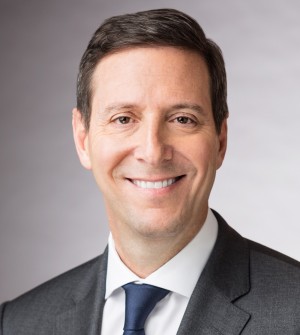
Scott Barshay (courtesy of Paul, Weiss; © Matt Greenslade)
The largest story in the law firm world this week is top M&A lawyer Scott Barshay’s surprise defection from Cravath to Paul, Weiss. Since the news emerged, we’ve heard different opinions about what he’s like to work for — but there’s no disagreement about his status as a leading corporate lawyer and the significance of his move.
There has been a fair amount of curiosity about how the deal for this dealmaker went down. Hence this follow-up story, peeling back the curtain a little on how the move got made.

Inside The Minds Working At US Midsize Law Firms: 2025 Priorities Revealed
Midsize firms want smarter tech, not more. Our 2025 industry report shows how the right tools—and strategy—can drive growth, efficiency, and better client outcomes.
According to the New York Times, Barshay got to know PW chair Brad Karp and corporate department head Robert Schumer when he worked with Paul, Weiss defending Xerox against activist investor Carl Icahn. But according to Bloomberg BNA, the official overture that ultimately resulted in Barshay’s hiring came through a longtime legal recruiter, Mark Rosen of Mark Bruce International.
Rosen said that the deal came together fairly quickly as partner moves go, in about two months. As he told Casey Sullivan of Bloomberg BNA, in February of this year Rosen called Brad Karp and communicated Barshay’s willingness to meet up and talk transition. Subsequent meetings — some of them over meals at Le Bernardin, according to Michael de la Merced of DealBook — culminated in Barshay’s lateral move.
Why did Scott Barshay make the move? According to Rosen, Barshay was “frustrated” or “not 100 percent happy” about some aspects of Cravath, and one of them was compensation. As we’ve previously discussed, Barshay stands to make a good bit more money under PW’s modified lockstep system compared to CSM’s pure lockstep system.
Indeed, as Julie Triedman noted in an Am Law Daily piece, the Barshay move raises questions about the viability of a hard-line lockstep model in an increasingly competitive world for talent. I reached out to longtime legal recruiter Sharon Mahn, one of the industry observers contacted by Triedman, and Mahn had this to say of pure lockstep: “Although the lockstep model is not going away anytime soon, it is understandably hard for partners with big books of business to resist market factors that can reward them with higher salaries at competing firms. It is not always just about the money when a partner jumps ship to another platform, but eight-figure compensation is certainly a strong motivation, and that puts the lockstep model under pressure.”

Reasoning, Tool Calling, And Agentic Systems In Legal LLMs
Domain-specific AI provides accuracy and reliable legal reasoning.
Of course, Cravath and culturally similar firms like Cleary and Debevoise might turn their noses up at money as a motivator for a move. We summed up that view in a 2012 story, Biglaw: It’s Not All About the Benjamins.
In fairness to Paul, Weiss and to Scott Barshay, however, (1) PW is a fairly lockstep firm, with 90 percent of partners getting paid based on seniority, and (2) Barshay made his move mainly because of excitement over the PW platform and the chance to grow its practice, as opposed to comp. As Mark Rosen told Bloomberg, Barshay “felt it was a great opportunity. It was the right time, and coming up as the global head of M&A at Paul Weiss was very exciting.”
Lawyers can minimize the importance of compensation and talk about the importance of serving their clients. Legal recruiters can similarly talk about helping candidates advance their careers, but it’s probably fair to say that legal recruiting, as a sales-focused business that’s not a profession in the same way as law, is more (even if not all) about the benjamins.
So how much might Mark Rosen have made from this placement? I posed this question to Sharon Mahn, who as a recruiter has moved prominent partners and practice groups from firm to firm.
“The standard fee is usually 25 percent of the candidate’s first-year base compensation, although it could range to anywhere from 20 to 30 percent of overall compensation, including bonuses,” she said. “If a group moves, it could be a sliding scale of 25 percent for the first partner, 20 percent for the second partner, and so on.”
Let’s assume, on the conservative side, that Barshay is getting paid a base of $8 million and that Rosen is getting just 20 percent. That’s a cool $1.6 million. On the high end, say 30 percent of $10 million total compensation, that’s $3 million. The actual figure probably lies somewhere in between, perhaps in the $2 million range. But there are some other factors possibly at play here, according to Mahn.
“Mark mentioned that he was ‘on retainer’ for a couple of years with Paul Weiss,” Mahn noted. “Under the retainer agreement, Paul, Weiss might have paid him some money up front to conduct their searches, but might have paid less on the back end once a candidate was placed at the firm.”
“Paul Weiss may have also ‘capped’ all candidate placements,” she explained. “That’s a caveat inserted in many law firm fee agreements to ensure that the recruiter fee is not extraordinarily high when it comes to large groups, law firm mergers, or in this case, a candidate that is bringing an astronomical sum of business to the firm with overall compensation to match. The usual cap is $1 million, sometimes $2 million. But it’s also possible Paul, Weiss in this case could have waived the fee cap, as Barshay is a one of the top corporate partners in the industry with an enormous client following.”
The bottom line: it’s hard to say exactly how much Mark Rosen made from this placement, but it’s safe to say that his fateful February phone call culminated in a seven-figure pay day. That might be a lot better than billing thousands of hours over the course of a year to break the million-dollar mark as a typical partner.
But before you run off to become a legal recruiter, you should know that it’s hard work. As described in this prior post, 5 Reasons To Become A Legal Recruiter, “Recruiting is not the easy money that it might sound like. You have to work hard every day to foster relationships and keep up with hundreds of people all the time. If you don’t like people, you won’t like recruiting. You also could go several months without a single placement….”
If you are entrepreneurial and can stomach that kind of risk, then recruiting might be right for you. But if you are risk-averse — indeed, if you went to law school precisely because of your risk aversion — you might prefer to stay right where you are, ignoring recruiters’ cold calls instead of making them.
Meet the Headhunter Who Placed Scott Barshay at Paul Weiss [Big Law Business / Bloomberg BNA]
A Cravath Partner Moves to Paul, Weiss [DealBook / New York Times]
Earlier: A Deeper Dive Into Scott Barshay’s Move From Cravath To Paul Weiss
5 Reasons To Become A Legal Recruiter